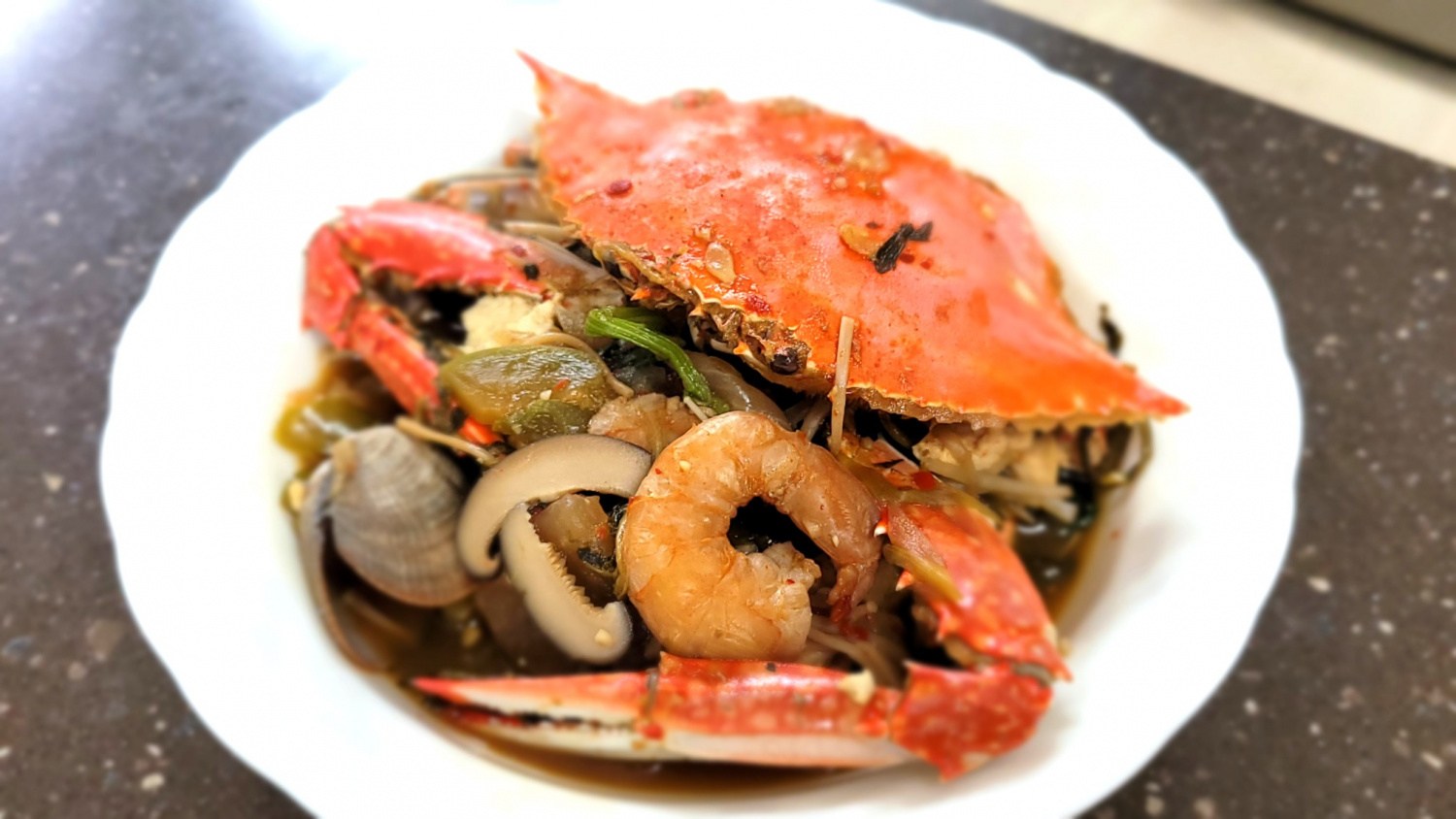Spicy and Refreshing Seasonal Blue Crab Stew (Kkotgetang)
Seasonal Blue Crab Stew: A Healthy and Nourishing Dish to Beat the Blues

It’s blue crab season in September, and these male crabs are incredibly plump! In these challenging times, let’s boost our spirits with delicious seasonal food and overcome any difficulties. **This blue crab stew rivals any restaurant’s taste – trust us and follow along!**
Ingredients- 3 Blue Crabs
- 6 Shrimp
- 200g Manila Clams
- 1/2 block Firm Tofu
- 2 Shiitake Mushrooms
- 200g Enoki Mushrooms
- 1/4 Korean Radish
- 1/2 Onion
- 1/3 Korean Zucchini
- 1 stalk Green Onion
- 100g Crown Daisy (Ssukgat)
- 2 sheets Dried Kelp (Kombu)
Seasoning- 1.5 tsp Doenjang (Korean soybean paste)
- 1 tsp Gochujang (Korean chili paste)
- 5 tsp Gochugaru (Korean chili flakes)
- 1 tsp Minced Garlic
- 0.5 tsp Minced Ginger
- 2 tsp Mirim (Rice wine for cooking)
- 3 tsp Soup Soy Sauce
- 0.5 tsp Coarse Salt
- 1.5 tsp Doenjang (Korean soybean paste)
- 1 tsp Gochujang (Korean chili paste)
- 5 tsp Gochugaru (Korean chili flakes)
- 1 tsp Minced Garlic
- 0.5 tsp Minced Ginger
- 2 tsp Mirim (Rice wine for cooking)
- 3 tsp Soup Soy Sauce
- 0.5 tsp Coarse Salt
Cooking Instructions
Step 1
First, prepare all the vegetables and mushrooms for the stew. Slice the Korean radish, onion, and Korean zucchini into bite-sized pieces. For the shiitake mushrooms, remove the stems and slice them. Separate the enoki mushrooms by cutting off the base and gently pulling them apart.

Step 2
Cut the firm tofu (1/2 block) into bite-sized cubes (approximately 2-3 cm) to prevent it from breaking apart too much while cooking.

Step 3
To remove any grit or impurities from the manila clams, we need to purge them. In a bowl, combine 200g of clams, 500ml of water, and 2 tsp of salt. Cover the bowl with a black plastic bag and let it sit in a cool place for 30-60 minutes. While the clams are purging, prepare the shrimp and blue crabs. (I used pre-cleaned shrimp for convenience.)

Step 4
It’s important to thoroughly wash the blue crabs to remove any dirt clinging to their shells. Use a toothbrush to scrub all the nooks and crannies, including the legs and underside, until they are sparkling clean.

Step 5
Using kitchen scissors, trim off the fin-like parts located on the rear legs of the blue crab for a neater appearance.

Step 6
Snip off the pointy mouth part of the blue crab with scissors.

Step 7
Carefully detach the triangular flap, known as the ‘belly button’, from the underside of the crab, starting from the direction indicated by the arrow.

Step 8
After removing the belly button, hold the crab’s shell with both hands on either side of the lower arrow and gently pull it in half. Crucially, remove all the feathery gill parts from inside the shell. These gills can harbor parasites and should always be discarded! You can choose to keep the collected innards to add richness to the broth, or discard them if you prefer a lighter flavor.

Step 9
Cut the cleaned blue crabs in half to make them easier to handle and to allow the flavors to meld better into the broth. This also makes them more convenient to eat.

Step 10
To create a rich and flavorful broth, start by combining 1 liter of water, 1.5 tsp of doenjang, 1/4 of the prepared Korean radish, 2 sheets of dried kelp, and 1 of the reserved crab carapaces in a pot. Simmer over medium heat to extract the flavors.

Step 11
Using just one crab carapace is sufficient to impart a wonderful umami flavor to the broth. The remaining carapaces can be used for decoration to enhance the stew’s visual appeal, or you can omit them if you prefer a cleaner taste. As the water begins to boil, you’ll notice the broth turning a beautiful, appetizing reddish-orange hue as the flavors infuse.

Step 12
Add 5 tsp of gochugaru to the broth to give it a spicy kick and a vibrant red color. Stir well to dissolve.

Step 13
Incorporate 1 tsp of gochujang for a touch of sweetness and depth of flavor. Make sure to stir it in thoroughly to avoid clumps.

Step 14
Add 1 tsp of minced garlic to enhance the fresh, clean taste of the stew.

Step 15
Stir in 0.5 tsp of minced ginger for a subtle zing. Adjust the amount according to your preference for ginger’s pungent flavor. (I used dried minced ginger.)

Step 16
Add 2 tsp of mirim (rice wine for cooking) to help eliminate any fishy odors from the seafood and to add a touch of savory sweetness.

Step 17
Pour in 3 tsp of soup soy sauce to deepen the overall flavor profile of the broth. You can adjust the seasoning with salt later if needed.

Step 18
Now, carefully add the prepared blue crabs, shrimp, and purged clams to the pot. Once the broth comes to a rolling boil, add all the remaining vegetables (onion, zucchini) and mushrooms (shiitake, enoki) except for the green onion and chili peppers. At this stage, taste the broth and adjust the seasoning. If it needs more saltiness, add the 0.5 tsp of coarse salt.

Step 19
Let the stew simmer gently for about 30 minutes, allowing the flavors of all the ingredients to meld beautifully into the broth. Finally, add the chopped green onion for freshness and the sliced chili peppers for an extra kick of heat. Simmer for another few minutes, and your delicious blue crab stew is ready!

Step 20
Ladle the piping hot, flavorful blue crab stew into serving bowls.

Step 21
Enjoy this delicious and hearty seasonal blue crab stew!




